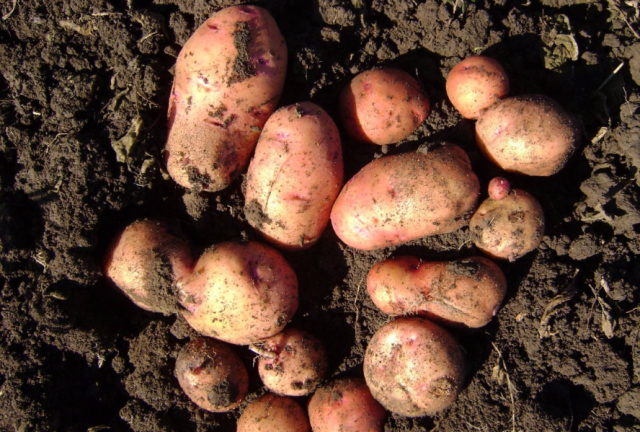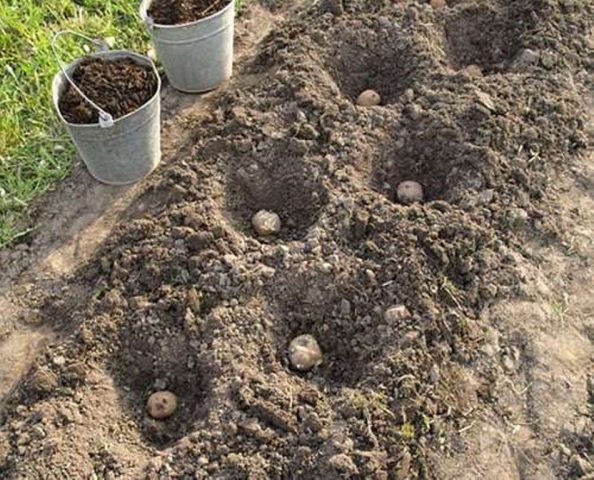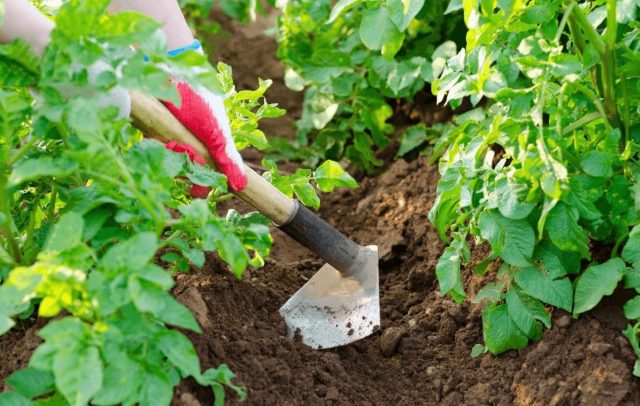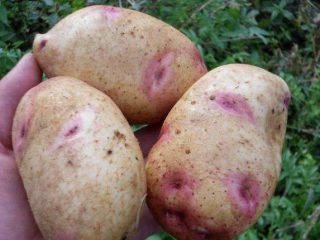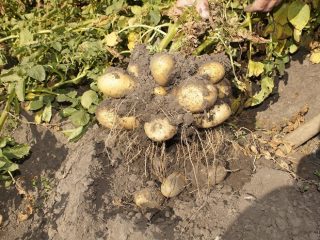Content
Explosive potatoes are an early ripe table variety bred by Russian breeders. The variety is high-yielding, resistant to diseases, has a long shelf life, good taste and presentation. Explosive potatoes are ideal for growing on a commercial scale, as they are unpretentious, drought-resistant, adaptable to any type of soil and climatic conditions.
Description of Potato Explosive
Explosive potatoes are early maturing varieties. The first crop is dug out 2 months after the appearance of young shoots. The bush forms up to 14 tubers with a bright pink skin and a juicy, dense yellow pulp. The variety is high-yielding, the weight of the root crop is up to 150 g.
Due to its unpretentiousness and immunity to many diseases, the Explosive potato variety is grown on an industrial scale. To obtain a rich harvest, potatoes are planted in a timely prepared and fertilized soil. The market yield, subject to agrotechnical rules, is 95%.
Thanks to their strong peel, potatoes are resistant to mechanical damage, which allows mechanical harvesting. The variety has a long shelf life and tolerates long-term transportation well.
It quickly adapts to any type of soil and grows well in all regions of Russia. Despite the fact that the potato is an explosive drought-resistant variety, with regular irrigation, the yield increases significantly.
Taste qualities of potatoes
The Vzryvnoy potato has excellent taste qualities. The starch content is up to 20% and depends on the frequency of irrigation, the introduction of organic and mineral dressings:
- the more feeding, the less starch;
- in dry summers, tubers are much richer in starch than in dry seasons.
Pros and cons of the Explosive potato variety
Explosive potatoes, like any variety, have their pros and cons. The advantages include:
- early maturity;
- high fruiting;
- disease resistance;
- lack of wateriness in tubers;
- drought-resistant;
- unpretentious care.
The disadvantages include the fact that the Explosive potato variety is often affected by viral infections.
Planting and caring for potatoes Explosive
It is better to purchase potato tubers of the Explosive variety from trusted suppliers. Since, when purchasing planting material on the market or from hands, you may not get varietal similarity.
Selection and preparation of the landing site
Potatoes are planted in a lighted area, in pre-prepared soil. The site for planting is prepared in the fall. To do this, it is dug up onto the bayonet of a shovel and organic fertilizing is introduced (manure, rotted humus or compost) and superphosphate in granules.
Preparation of planting material
When purchasing tubers for planting, you need to know that they must be large, even, the color must correspond to the varietal characteristics. Mechanical damage and deformation of root crops reduces yield and leads to the appearance of diseases.
In order for the planted potatoes to form into a powerful bush and give a good harvest, it is necessary to awaken the eyes. To do this, you can use one of the methods:
- 10 toothpicks are placed in the potatoes at a shallow depth;
- a 3 mm incision is made across the entire area, trying not to touch the place where the sprouts will appear;
- planting material is strung on a fishing line and left for 5 days in a well-lit room;
- wet germination.
Landing rules
Potatoes can be planted in several ways. But in order for the plant to receive a sufficient amount of light, it is necessary to observe the interval between plantings and plant roots strictly from south to north.
The planting depth also affects the yield:
- on sandy soil - 10-15 cm;
- on peat - 8-10 cm;
- on clay - 4-5 cm.
Smooth fit is the easiest and most popular method. Depressions are made in the ground, filled with humus and wood ash, and tubers are planted at a distance of at least 50 cm. Potatoes are sprinkled with earth, spilled and mulched.
The good thing about the method is that it is simple to execute and does not require additional expenditure of effort and time. Many gardeners have found the disadvantages of this method:
- low productivity;
- planting material is not protected from adverse climatic conditions;
- not suitable for clayey soil.
Ridge landing is an old, proven method. Suitable for all types of soil and for planting in cities with unstable climates.
The site for planting is dug up in the fall, mineral and organic fertilizers are added. In the spring, the beds are marked, leaving an interval between the rows of at least 70 cm. In early spring, in dry weather, ridges with a height of 15 cm are formed. The planting material is laid out in rows, sprinkled with earth and spilled abundantly.
After the shoots reach 20 cm, hilling is carried out, lifting the soil from the row spacing to the garden bed. This procedure is performed three times a season until the crest rises to half a meter.
The advantages of the method:
- can be used on an area with surface groundwater contact;
- suitable for clay soil;
- gives high fruiting;
- easy harvesting.
The disadvantages of the method, many gardeners include:
- not suitable for southern regions;
- requires a well-fertilized area.
Watering and feeding
Proper irrigation affects a high yield. If the summer turned out to be not dry, 3-times watering per season is enough for potatoes of the Explosive variety:
- the first irrigation is carried out after the tops begin to actively grow;
- the second - during flowering, when the plant begins to form tubers;
- the third - 2 weeks before harvest.
The need for irrigation can be determined by the soil, if the soil obtained from a depth of 6 cm is hard and crumbles, it means that the earth does not have enough moisture.
To retain moisture, the soil is mulched after irrigation. Fallen leaves, straw or rotted compost are used as mulch.
Explosive potatoes are responsive to feeding, which is applied 3 times per season. Nitrogen fertilizing is applied at the beginning of the growing season. To do this, dilute 1 tbsp in 10 liters of warm water. l. urea. Up to 1 liter of the prepared solution is consumed under each bush. The second time the bushes are fertilized during budding. For this, phosphorus-potassium fertilizers are used. During flowering, superphosphates are used in granules. Thanks to superphosphates, the root system is built up and the formation of tubers is accelerated.
Also, many gardeners use wood ash as top dressing. It not only saturates the plant with phosphorus and potassium, but also saves the bush from rotting in wet weather and protects it from the Colorado potato beetle.
Loosening and weeding
Loosening and weeding of potato bushes is an important care component. Since the weed takes away many useful trace elements from potatoes, which are necessary for the formation of tubers. If the beds are not mulched, then after each watering, they carefully loosen and remove weeds.
Hilling
You cannot get a generous harvest without hilling. This procedure provides the following advantages:
- the bush will get stronger and will not lie down in strong winds;
- during returnable spring frosts, the planting material will not freeze;
- a powerful root system is formed;
- yield increases;
- the earth is saturated with oxygen;
- convenient harvesting.
In certain cases, potato beds do not need to be piled up:
- if grown in hot climates;
- with a special way of growing: under a film, in hay or in bags.
Since the Explosive potato is an early ripening variety, hilling is carried out 2 times. The first is 2 weeks after planting, when the seedlings reach a height of 10 cm. Hilling is carried out in such a way that a top 2 cm high remains above the ground surface. The second is during budding, when the bushes reach 30 cm.
Hilling is best done on wet ground in the morning or evening. Since it is better to make ridges from wet soil, and it stimulates the growth of underground shoots, on which tubers will begin to form in the future.
Diseases and pests
Variety Vzryvny has strong immunity to potato crayfish, scab and late blight. But he is often affected by viral infectious diseases.
- Rhizoctonia - a common, harmful disease that appears in the cold, early spring. The disease is dangerous because the affected tuber does not sprout. The disease often affects weakened plants, so tubers are recommended to be disinfected and germinated before planting.
- Bronze of leaves - the disease develops from a lack of potassium, as well as when grown on peat soil. The first signs of the disease: the lower leaves become shriveled and turn bronze.
- Mottling - affects tubers and leaf plate, which over time begins to color unevenly. If timely assistance is not provided, the yield decreases, and the taste of the tubers deteriorates.
- Colorado beetle - a dangerous pest of potatoes. Beetles and larvae destroy tubers and aerial parts in a short period of time.
Potato yield
From the description, photos and reviews of gardeners, it can be seen that Explosive potatoes are a high-yielding variety. Subject to the rules of care, each bush forms 8-10 tubers, weighing up to 150 g.
Explosive potatoes are universal varieties. It can be used for boiling, frying, making chips and fries.
Harvesting and storage
Young early potatoes begin to be harvested in late June, early July, after flowering ends, and the tops begin to turn yellow and dry. To understand that the tubers have reached a varietal size, a test dig is made. To do this, the bush is carefully dug out with a pitchfork and pulled by the tops.
After the potatoes have been dug up, they are sprinkled on plastic wrap and left to light for several hours. Before laying for storage, the crop is selected by removing rotten and root crops with mechanical damage.
For better storage, the harvested crop is processed in a solution of copper sulfate. The selected and prepared crop is laid out in boxes and harvested in a dry, cool, dark place. The optimum temperature for long-term storage should not exceed + 4 ° C, since at elevated temperatures the potatoes will begin to sprout.
Conclusion
Explosive potatoes are an early ripe, high-yielding variety that can be grown in all regions of Russia. It is unpretentious, has good taste, has a long shelf life and is suitable for growing on an industrial scale.
